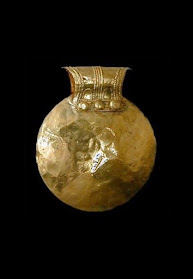 |
| Etruscan gold bulla amulet |
The Roman bulla is a round amulet worn by boys to ward off evil spirits. It consists of two convex plates and is typically given to a boy eight days after his birth, coinciding with the day he is named. It also symbolizes the status of being a freeborn child.
Materials: The materials used to craft a Roman bulla varied depending on the family's status:
- Silver, Gold, or Bronze: Bullae made of precious metals like silver or gold were reserved for high-status families. These bullae were likely more ornate and luxurious in design.
- Bronze: Less expensive bullae were made from bronze, which was a more accessible material. They would still provide protection but were less extravagant.
- Leather: In some cases, bullae could be crafted from leather, especially for families with more modest means. Leather bullae were simpler in design but served the same protective purpose.
The Roman tradition of wearing bullae was influenced by the Etruscans, and it played a significant role in the cultural practices surrounding the birth and naming of children in ancient Rome.
No comments:
Post a Comment